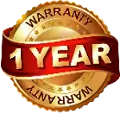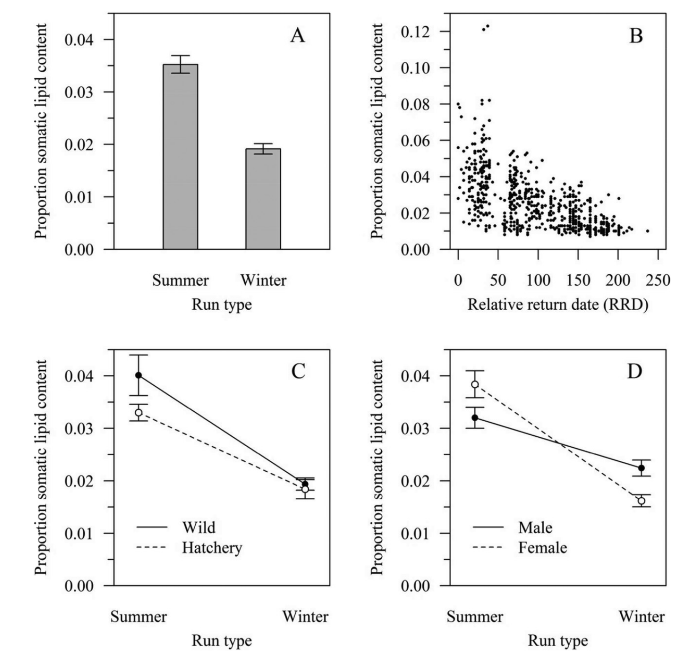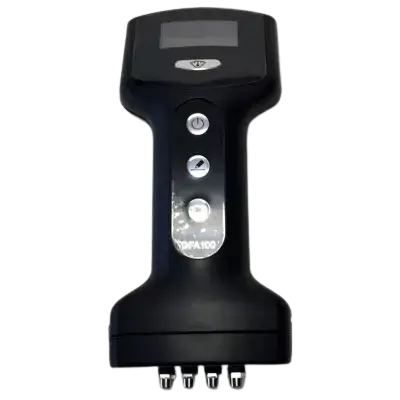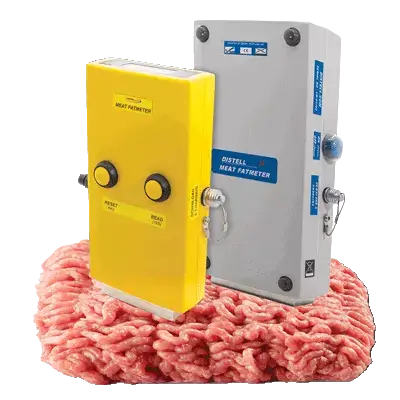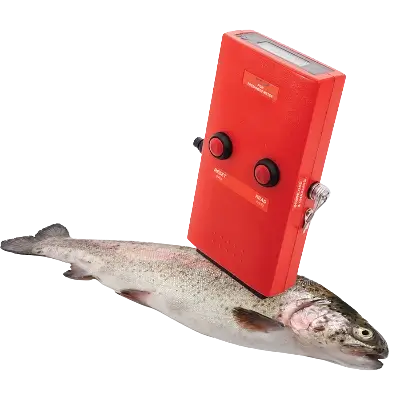Fish Fat Meter
Fish Fat Meter measures fish fat (lipid) content percentage accurately in seconds. Hand held, durable and all day battery life that comes in two sizes to meet your needs.
To purchase, Click on Get a Quote Now below:
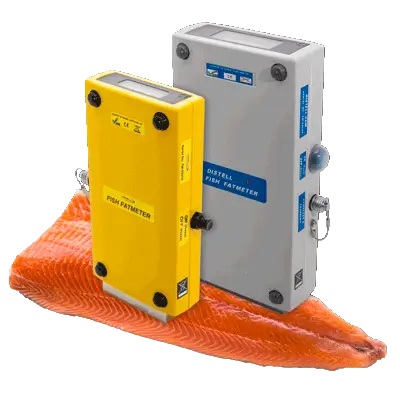
What is a Fish Fat Meter?
Fish Fat Meter is a hand held device that measures fish fat (lipid) content percentage in seconds. It’s accurate, easy to use and trusted world wide by top researchers, Scientists, fish & seafood market quality assurance specialists.
Fish Fat Meter is a hand held, durable for outdoor use and non-destructive device so that you can use the fish safely after measuring it.
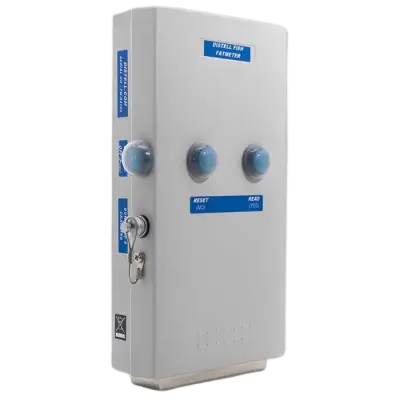
Results in seconds
Accurate & instant results to make on the spot decisions.
Handheld & Portable
Just like the size of a smartphone, carry it anywhere you like.
Rugged & Durable
Made for outdoor use and water proof to IP65 standards.
Long battery life
Up to 8 hours of all day use. Go for a long field measurements.
Non destructive
No harm done to your fish or the meat being measured.
Ease of use
Anyone can measure right out of the box, with no special training.
How does the Fish Fat Meter work?
The fish fat (lipid) content measurement is based on the fish water content that is measured by the micro-strip sensor. From the fish water content, the device uses its proprietary calibration algorithm to provide the fish fat (lipid) percentage results.
The Fish Fat Meter was developed and refined the algorithm based on years of research through experience & customer feedback. Its been tested, proven and trusted by world’s most demanding customers for many years.

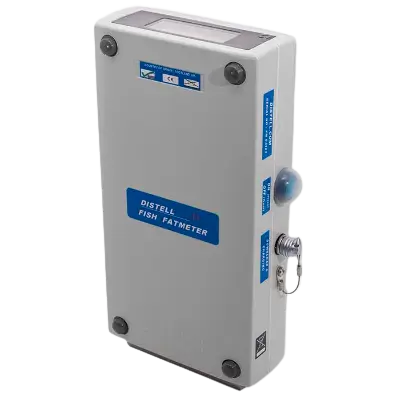
How accurate is the Fish Fat Meter?
The accuracy of the Fish Fat Meter depends on the overall fat (lipid) content percentage of the fish, please refer to the accuracy guide.
How to read the accuracy guide: when using the Fish Fat Meter and you get a fish fat percentage from 2% to 15%, the accuracy is about ± 0.5% to ± 1.0%.
If the fish fat (lipid) content percent is from 16% to 30%, the accuracy is about ± 1.0% to ± 2.0% and so on. As the total fish total fat (lipid) content increases, so does the percentage of variance in accuracy.
Accuracy Guide:
| Fish Fat (lipid) content percentage results | Accuracy |
|---|---|
| 2% to 15% | ± 0.5% to ± 1.0% |
| 16% to 30% | ± 0.5% to ± 1.0% |
| 31% and above | ± 0.5% to ± 1.0% |
What types of fish can the Fish Fat Meter measure?
32 fish types with 73 settings!
The Fish Fat Meter can measure 32 fish types (species) of fish with 73 possible setting.
For every purchase or rental, you get to choose up to 4 species to be pre-calibrated to the device and a “Research” setting to make your own calibration if needed.
| Anchovy (South African) Engraulis encrasicolus Engraulis capensis | Mackerel – Horse Mackerel (Atlantic/North Sea) Trachurus | Sardine (Pacific/Asiatic) Sardinops melanoticta | STrout (Rainbow Trout) Salmon gairdneri Salmon irideus |
| Argentine/Smelt (Atlantic/North Sea) Argentina | Mackerel – Blue Mackerel (Atlantic/North Sea) Scomber Scrombus | Sardine (Spanish) Sardinella Aurita | Tuna – Bluefin (Atlantic, Pacific, Mediterranean) Thunnus Thynnus |
| Butterfish Pholis gunnellus% to 15% | Mackerel – Jack Mackerel (Pacific, Asiatic) Trachurus murphyi | Saury (Pacific) Saurus | Tuna – Bonito (Atlantic, Pacific, Mediterranean) Sarda sarda Sarda Chiliensis |
| Carp (Fresh Water) Cyprinus Carpio | Mackerel – Chub Mackerel (Pacific, Asiatic) Scomber japonicus | Sprat (Atlantic/North Sea) Sprattus sprattus | Tuna – Albacore (Atlantic, Pacific, Mediterranean) Thunnus Alalunga |
| Arctic Char (Arctic) Salvelinus | Mackerel – West African (Atlantic/Mediterranean) Scomberomorus tritor | Sea Bass Dicentrarchus Labrax | Tuna – Skipjack (Atlantic, Pacific, Mediterranean) Katsuwonus pelamis |
| Eel (Farmed eel) Anguilla anguilla | Salmon (Atlantic) Salmo salar | Sea Bream, Black Bream (Mediterranean) Spondyliosama Cantharus | Tuna – Yellowfin (Atlantic, Pacific, Mediterranean) Thunnus Albacares |
| Hake (European hake) Merluccius merluccius | Salmon (Pacific) Oncorynchus Neuka Oncorhynchus Kisutch Oncorhynchus Tshawytscha | Sea Bream, Gilthead Bream (Mediterranean) Sparus aurata | Whiting – Blue Whiting (Atlantic, North Sea) Micromesistius poutassou |
| Herring (Atlantic/North Sea) Clupea harengus | Sardine (Atlantic/North Sea) Sardina pilchardus | Silver Warehou (Pacific) Seriolella Punctata | Research Setting – Used to measure product where no specific calibration is available (Custom calibration) |

Research
Conduct Government, University & Non-profit research projects.

Quality Control
Objective data driven results to ensure consistent quality.

Grocery Stores
Analyze supplier quality level, reduce waste and prolong shelf life.
Who & How do people use the Fish Fat Meter?
Researchers, Scientists & Lab Technicians
Used in key US Government research projects to monitor fish growth & health.
Seafood Market Quality Assurance
To measure quality from suppliers to improve logistic or storage techniques. Determine shelf life & adjust price accordingly.
Aquaculture’s, Fish Farms & Estuary’s
Ensure health of the fish & right amount of feed is used to grow the fish.
Restaurants
To ensure seafood received from suppliers meets agreed upon quality level so that they can serve the best seafood to customers.
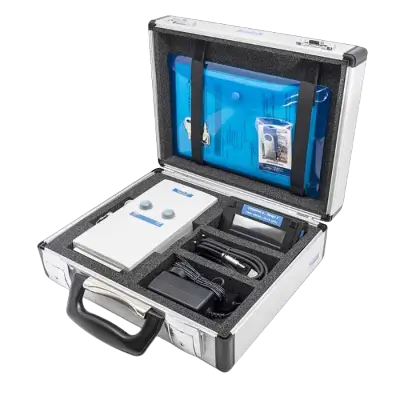




Easy To Use & Rugged
Only three buttons: On/Off, Reset & Read. Turn it on, select the fish type & measure. Yes, it’s that simple!
Ease of use:
Rugged & Ready for outdoor use:

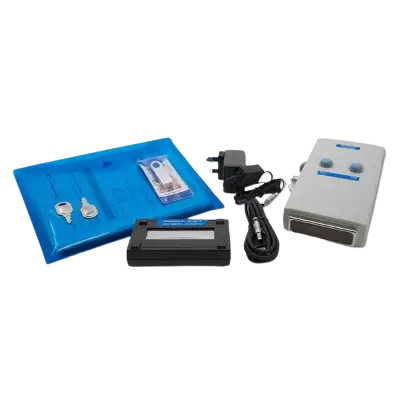
Fish Fat (lipid) content percentage results in Seconds & Non-destructive
Depending on the size of the fish, take 1 to 4 measurements per fish for reliable & accurate reading. You’ll get an “average” of those readings as the fish fat (lipid) percentage.
The Fish Fat Meter was designed to be used on live fish so it does no harm to the fish. You can use the fish or sell it with confidence to your customers.
Any limitations of the Fish Fat Meter?
No device is perfect and here are some limitations of the Fish Fat Meter you need to be aware of:

Fish Fat Meter comes in 2 sizes: FFM 992 (Small) & FFM 692 (Big)
Fish Fat Meter offers 2 sizes depending on the size of the fish you’re measuring.
Which size do i need? We recommend the following:
- Fish smaller than 2.5 inches, we recommend the small (FFM 992) device.
- Fish bigger than 2.5 inches, we recommend the big (FFM 692) device.
| FFM 992 (Small) | FFM 692 (Big) | |
| Device Size | 5.9 x 3.15 x 1.18 inch (150 x 80 x 30 mm) | 7.68 x 3.94 x 1.57 inch (195 x 100 x 40 mm) |
| Weight | 0.88 lbs (400 grams) | 1.6 lbs (725 grams) |
| Sensor size | 1.97 x 1.0 x 0.4 inch (50 x 25 x 10 mm) | 3.15 x 1.0 x 0.4 inch (80 x 25 x 10 mm) |
| Shipment weight for 1 device | 6.6 lbs (3 kg) | 8.6 lbs (4 kg) |
| Minimum fish body size (length) it can measure | 1.5 inches (40 mm) | 2.36 inches (60 mm) |
| Minimum fish body thickness needed | 0.28 inch (7 mm) |
| Meter casing material | ABS plastic with IP65 water proof |
| Sensor operating frequencies | 1.975 GHz (+/- 20 MHz) |
| Battery type | Internal rechargeable: Nickel Metal Hydride (NiMH) |
| Battery life | 8 hrs continuous use |
| Battery recharge time | 12 to 15 hours from empty |
Fish Fat Meter FAQ
Blogs & Research Papers
Other Related Products
To Purchase, call or email
